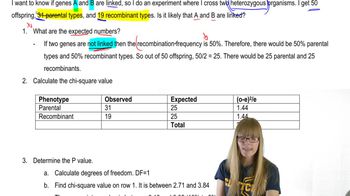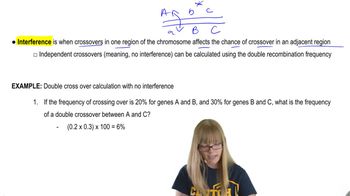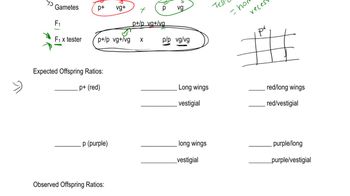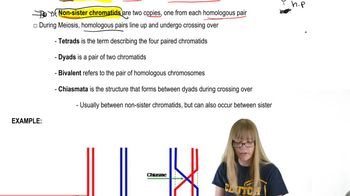Table of contents
- 1. Introduction to Genetics51m
- 2. Mendel's Laws of Inheritance3h 37m
- 3. Extensions to Mendelian Inheritance2h 41m
- 4. Genetic Mapping and Linkage2h 28m
- 5. Genetics of Bacteria and Viruses1h 21m
- 6. Chromosomal Variation1h 48m
- 7. DNA and Chromosome Structure56m
- 8. DNA Replication1h 10m
- 9. Mitosis and Meiosis1h 34m
- 10. Transcription1h 0m
- 11. Translation58m
- 12. Gene Regulation in Prokaryotes1h 19m
- 13. Gene Regulation in Eukaryotes44m
- 14. Genetic Control of Development44m
- 15. Genomes and Genomics1h 50m
- 16. Transposable Elements47m
- 17. Mutation, Repair, and Recombination1h 6m
- 18. Molecular Genetic Tools19m
- 19. Cancer Genetics29m
- 20. Quantitative Genetics1h 26m
- 21. Population Genetics50m
- 22. Evolutionary Genetics29m
4. Genetic Mapping and Linkage
Crossing Over and Recombinants
Problem 21b
Textbook Question
Gene R and gene T are genetically linked. Answer the following questions concerning a dihybrid organism with the genotype Rt/rT:
Can you make a general statement about how the occurrence of two crossover events between a given pair of linked genes affects the estimate of recombination frequency? (Hint: Think about this problem for a gene pair with a small recombination frequency versus a gene pair with a much higher recombination frequency. See also Figure 5.10.)
 Verified step by step guidance
Verified step by step guidance1
<span>Step 1: Understand the concept of genetic linkage and recombination frequency. Genetic linkage occurs when genes are located close to each other on the same chromosome, leading to them being inherited together. Recombination frequency is the percentage of offspring that inherit a combination of alleles different from either parent due to crossing over during meiosis.</span>
<span>Step 2: Consider the effect of a single crossover event. A single crossover between two linked genes can result in recombinant gametes, which increases the recombination frequency. The closer the genes are, the less likely a crossover will occur between them, resulting in a lower recombination frequency.</span>
<span>Step 3: Analyze the impact of two crossover events. When two crossover events occur between the same pair of genes, they can potentially cancel each other out, leading to a non-recombinant configuration. This means that the recombination frequency might be underestimated if double crossovers are not accounted for.</span>
<span>Step 4: Compare scenarios with different recombination frequencies. For gene pairs with a small recombination frequency, double crossovers are less likely, and their impact on recombination frequency estimates is minimal. However, for gene pairs with a higher recombination frequency, double crossovers are more common and can significantly affect the accuracy of recombination frequency estimates.</span>
<span>Step 5: Conclude with a general statement. Double crossover events can lead to an underestimation of recombination frequency, especially in gene pairs with higher recombination frequencies, as they can restore the original parental configuration, masking the occurrence of recombination.</span>
Recommended similar problem, with video answer:
 Verified Solution
Verified SolutionThis video solution was recommended by our tutors as helpful for the problem above
Video duration:
1mPlay a video:
Was this helpful?
Key Concepts
Here are the essential concepts you must grasp in order to answer the question correctly.
Genetic Linkage
Genetic linkage refers to the tendency of genes located close to each other on a chromosome to be inherited together during meiosis. This occurs because linked genes are less likely to be separated by recombination events. Understanding linkage is crucial for predicting inheritance patterns and calculating recombination frequencies, which indicate how often genes are separated during gamete formation.
Recommended video:
Guided course

Chi Square and Linkage
Recombination Frequency
Recombination frequency is a measure of the likelihood that two genes will be separated during meiosis due to crossing over. It is calculated as the number of recombinant offspring divided by the total number of offspring. A low recombination frequency suggests that genes are closely linked, while a high frequency indicates they are further apart, allowing for more frequent crossover events.
Recommended video:
Guided course

Recombination after Single Strand Breaks
Crossover Events
Crossover events occur during meiosis when homologous chromosomes exchange segments of genetic material. The number of crossover events between linked genes can significantly influence the recombination frequency. In cases with two crossover events, the likelihood of producing recombinant gametes increases, which can lead to a more accurate estimate of the genetic distance between the genes involved.
Recommended video:
Guided course

Multiple Cross Overs and Interference

 7:52m
7:52mWatch next
Master Gamete Genotypes with a bite sized video explanation from Kylia Goodner
Start learning




